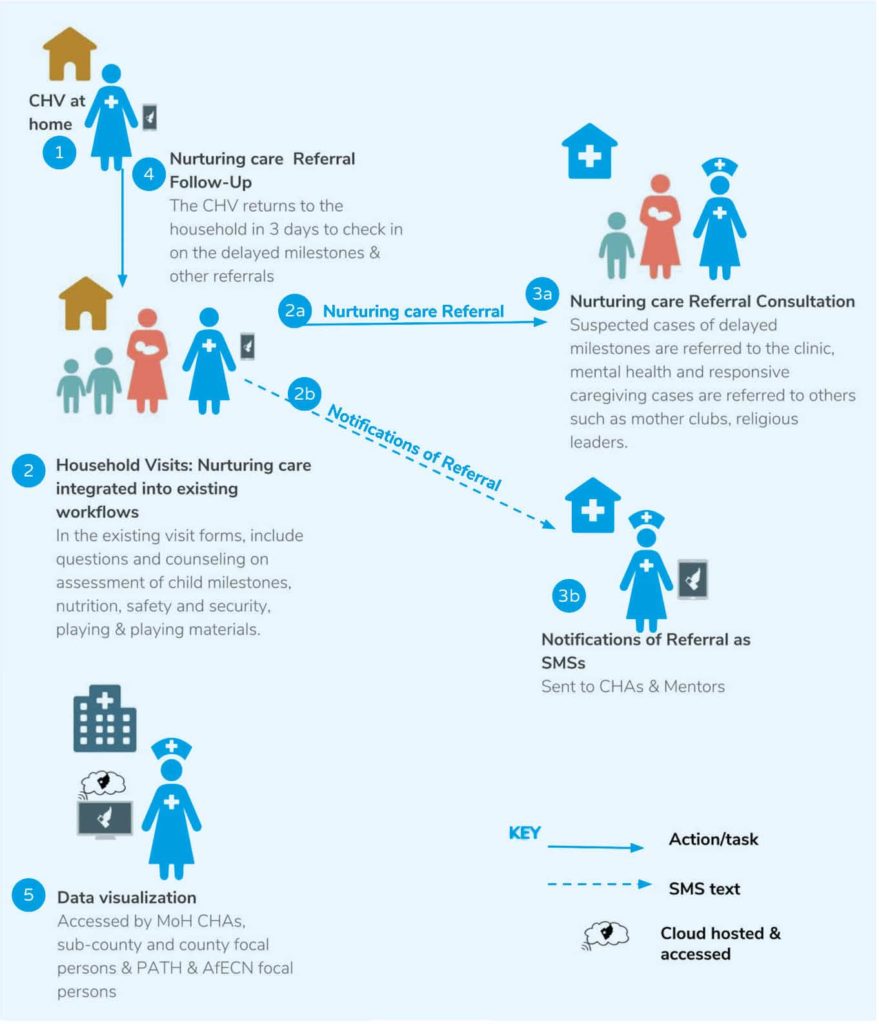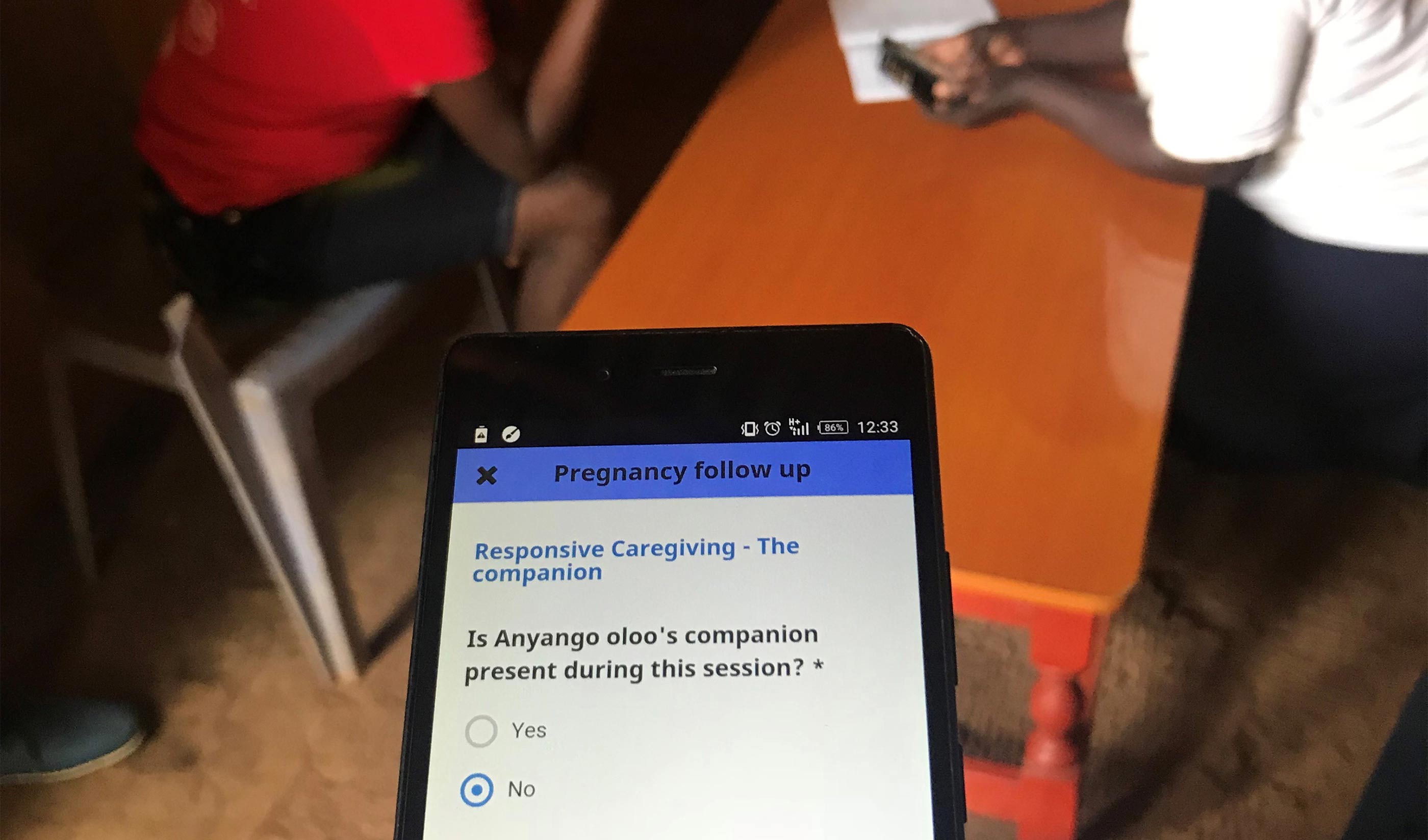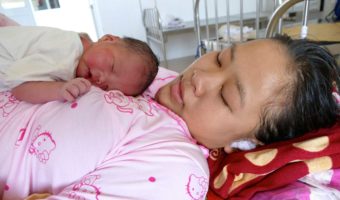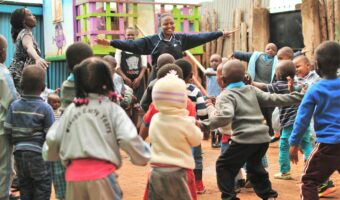In many low- and middle-income countries, community health workers (CHWs) are the touchpoints between the health system and caregivers, infants and toddlers. Alongside their core responsibilities – health promotion and delivering basic treatments (Barger et al., 2017) – they are increasingly being asked to take on new tasks, including antenatal and postnatal services (Kirkwood et al., 2013), disease surveillance, supporting anti-retroviral compliance (Mwai et al., 2013), and deworming (Clohossey et al., 2014).
CHWs are also being tasked with promoting optimal child health and development, with some promising impacts, as seen in Pakistan (Yousafzai et al., 2014). However, there are concerns about asking more and more from this overstretched cadre (Tomlinson, 2018). CHWs are frequently under-staffed, poorly paid, and not always provided with the necessary tools and resources (Cometto et al., 2018).
New tools for supporting this cadre are emerging, including mHealth platforms, which use smartphones as job aids. They can assist with prioritisation, tracking, workload management and decision making. For example, they can enable local clinics to alert CHWs to newly pregnant women in their catchment area. They can keep supervisors informed about workload and performance in real time. They can guide CHWs through evidence-based workflows, helping with screening and diagnosis while also collecting data.
When combined with other interventions – such as improvements to pay, training and supervision – mHealth platforms are showing encouraging results and their use is growing rapidly (Sondaal et al., 2016).
Developing an mNurturingCare app
So far, the focus of most mHealth approaches has been health (Braun et al., 2013). Support for early childhood development has generally been limited to nutrition screening and counselling. With growing recognition of the need to move from ‘survive’ to ‘thrive’ (Braun et al., 2013), in 2018 we convened an innovative collaboration among the following organisations:
- Medic Mobile – with digital health solutions supporting over 25,000 CHWs in 23 countries, they brought expertise in mHealth application development, deployment and testing, and an opportunity to field test within an existing planned deployment in Siaya County, Kenya (Medic Mobile, online).
- PATH – with their pioneering work to integrate nurturing care into health systems, they brought tools, strategies and content in traditional ‘analogue’ capacity development approaches, such as training, supportive supervision and hard copy job-aids, as shown in Figure 1 (PATH, 2012).
- The African Early Childhood Network (AfECN) – with their work to scale- up innovative approaches in early childhood development, they brought expertise on capacity development and policy engagement across Africa (AfECN, online).

Figure 1: Conventional ‘analogue’ job aids
As summarised in Figure 2, the aim of the mNurturingCare app was to build promotion of responsive caregiving into clinical encounters and use the mHealth platform for basic developmental screening and referral where needed. For example, during antenatal visits, content on child health and development is built into workflows, as well as communicating the rationale for breastfeeding; the application prompts health workers to discuss the importance of talking, singing and playing for children’s development. Postnatally, the application encourages them to assess interaction between caregiver and baby, and to offer coaching on play and stimulation. The content and workflows were developed with the participation of end users from the start. Workshops were held in Siaya County and the urban context of Nairobi County. Over several iterations of the app, content was simplified and clarified, referral triggers more clearly signalled, and a dashboard developed to present the information that supervisors needed. Initially 30 health workers, known as Community Health Volunteers (CHVs) in Kenya, were trained in each location, and they used the app for four weeks.

Figure 2: Content and work flows of the mNurturingCare application
Emerging insights from field testing
Follow-up focus group discussions were overwhelmingly positive, especially among younger and tech-savvy CHVs. They appreciated the advantages over hard-copy registers and logbooks, and did not seem to resent the application reducing their work to being about following algorithms – although this may reflect the quality of the pre-deployment training.
We cannot remember everything. Since when we got this app we do not leave anything out and we are able to give all the information to the caregivers. It has made our work easier, no more hard copy. … I was pleased when a mother delivered and when I clicked, I found it automatically updated unlike previously when you had to register the baby again.
Interestingly, the mHealth technology seemed to enhance their social status:
When community members see you having and using a phone, they rate you somewhere, not just as a mere [CHV].
Hardware and connectivity posed some challenges: the app worked slowly on older phones, and in many areas video content could not be reliably accessed.
… one challenge is on the phone battery for those in rural areas without power connection who have to charge in kiosks with power.
Data protection and security will require appropriate policy and regulatory frameworks. However, CHVs highlighted the value of digital systems in ensuring data integrity:
You can’t cook the data [with the app] … You have to actually go to the households!
The pilot was also a reminder that strengthening CHV capacity can expose weaknesses elsewhere in the health system: CHVs using the app could effectively screen for child development concerns, but this then exposed limitations in access to skilled child development specialists for follow-up assessments and intervention.
Next steps
Further work on mNurturingCare is currently underway. Data is being reviewed to see if the app affects the length and number of consultations a CHV conducts in an average workday. Discussions with the Ministry of Health are exploring the potential for further deployment in Kenya as part of the 2014–2019 National Community Health Strategy, national nurturing care implementation, and plans towards achieving universal health coverage.
There are also opportunities to work in other countries that are currently scaling-up mHealth (but with a focus on health rather than broader child development), and those who are currently working to integrate nurturing care into their health systems, (but without digital tools). We are also comparing lessons learned with others attempting to integrate nurturing care into mHealth platforms, such as D-tree in Zanzibar (D-tree International, online).
It remains important to test whether mNurturingCare can deliver additional impact compared to simply training, supervising and paying CHWs properly. Nevertheless, in an increasingly digital world, there seems to be considerable potential for mNurturingCare to support community health workers to improve early childhood development.
References can be found in the PDF version of the article.





